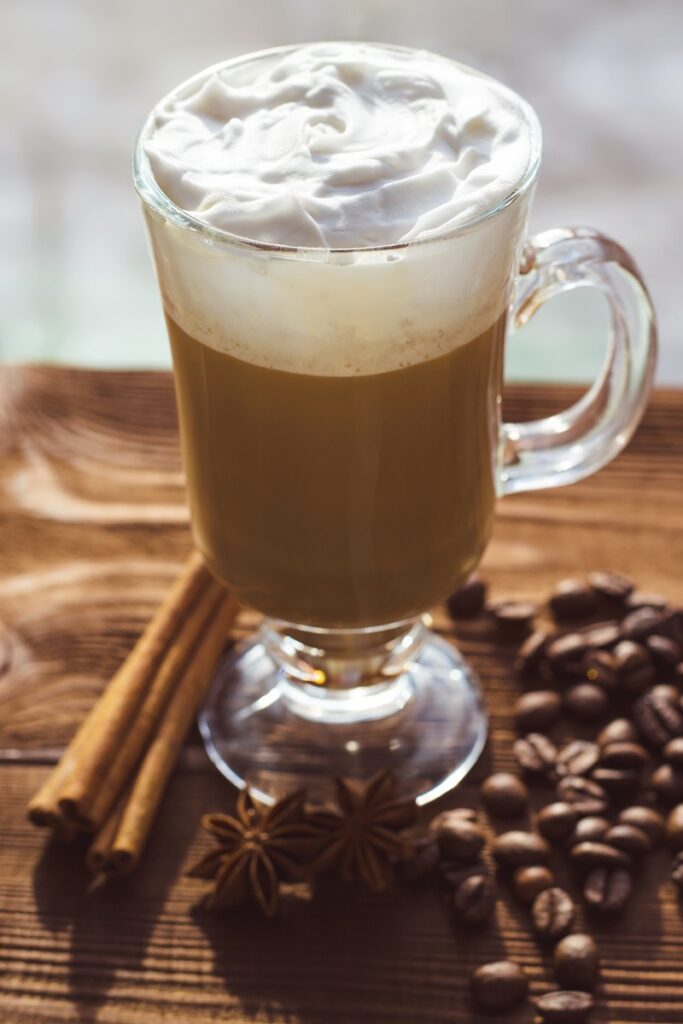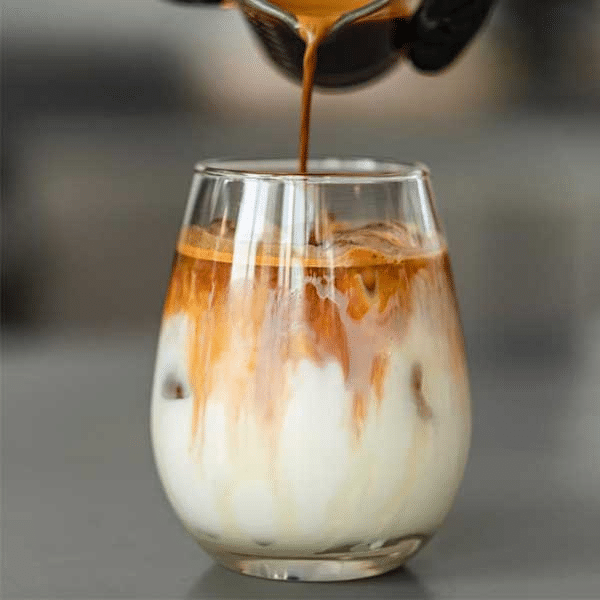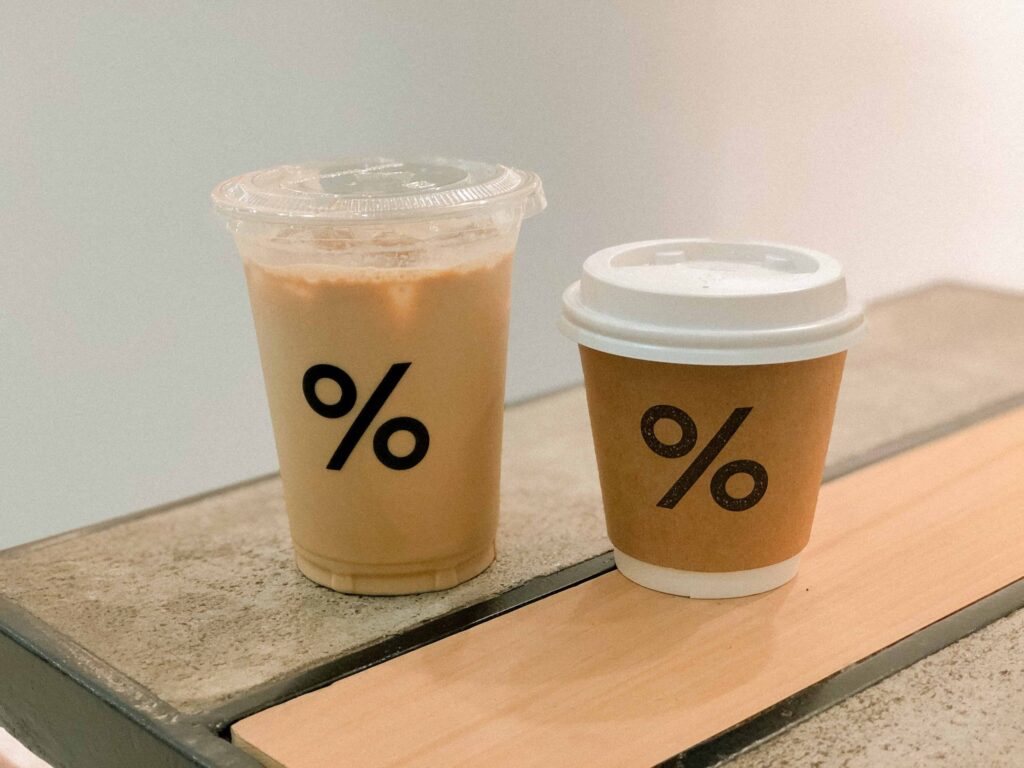Hello, my coffee aficionados; I know that you hop on every other coffee trend, such as peanut butter and colada coffee, to try out its unique taste. But let me introduce you to the show-stopper of these variations, i.e., Spanish Latte. No doubt, it is one of the most consumed beverages all around the world, especially in the Gulf region. It is the mixed goodness of espresso and condensed milk. Now, you might be thinking that it is a Spanish beverage; no, that’s partially true. We can say that it is a concoction of two Spanish drinks i.e., Café con Leche and Café Bombón. So, if you have ever seen a barista playing with espresso and condensed milk, don’t get confused. It’s the Spanish latte which you can also make at home following our article guide.

Grasp the Concept of Spanish Latte: A Flavorful Concoction
Are you wondering what is a Spanish latte and what makes it different from other coffee drinks? Don’t worry we have got you covered. A Spanish Latte is a rich coffee drink that blends the creamy texture of steamed milk, often sweetened with condensed milk, with the intense flavor of espresso coffee. It comes from Spain and is a staple in many coffee shops across the world. This drink has a rich, velvety flavor profile that is a great blend of powerful coffee beans and the sweetness of condensed milk.
Additionally, it’s a unique blend of Café con Leche and Café Bombón, two traditional Spanish coffee beverages. While sharing similarities with a classic latte, the Spanish Latte stands out by its rich richness and unique flavor. A favorite among coffee connoisseurs looking for an extravagant caffeine fix, it is also well-known for its silky texture and creamy consistency in addition to its wonderful taste.
However, if you want to explore the major differences between the regular latte and the Spanish latte, check out Aneliese’s article.

Origins of Spanish Latte: Exploring Its Rich Roots
The roots of the Spanish Latte can be traced back to Spain, a nation well-known for its extensive coffee culture. Coffee is more than simply a drink; it’s a beloved cultural tradition that is part of everyday life in Gulf regions. The Spanish Latte has unknown origins. However, it most likely developed over time as a riff on classic Spanish espresso drinks. influence of Spain on places like Latin America, where coffee production flourished, contributed to the influence of Spain on coffee culture. Coffee became popular again with Spanish settlers, who also brought condensed milk and other ingredients that later made their way into local coffee recipes. The blending of flavors and methods in coffee production was further helped by Spain’s ancestral connections to nations such as Cuba.
The result of mixing many flavors and ideas was the Spanish Latte, a sweet and rich coffee drink renowned for its sweetness and smoothness. The Spanish Latte, which reflects the essence of Spain’s vibrant coffee culture, has grown to be a popular specialty drink that is enjoyed at cafés all over the world. Furthermore, variations like the iced Spanish Latte and the latte in Spanish continue to shift to suit a range of tastes in hot and cold coffee.

Brew Perfection: A Guide to Making Spanish Latte
Now, that you have explored the origins of this beverage, you might be thinking about how to make a Spanish latte at home. Well, we have got you covered. This article is going to cover the details of ingredients and the easiest recipe steps for a delicious delight.
Ingredients Needed for Making Spanish Latte
Below are the ingredients to make this indulgent treat:
1. Espresso Coffee
The first ingredient is espresso. Made by applying high pressure to finely ground coffee beans, espresso is a concentrated version of coffee with milk. Rich crema, the golden layer of foam on top, and its intense flavor are what define it. Espresso forms the base of a Spanish Latte, giving it a rich and intense coffee flavor which serves as the drink’s base.
2. Condensed Milk to Balance Out Espresso Flavors in Spanish Latte
The second ingredient is condensed milk is made by adding sugar to scalded milk after the water has been drained, giving the mixture a thick, syrup-like consistency. It balances the potency of the espresso by giving the Spanish Latte a creamy richness and sweetness. The Spanish Latte has a very rich flavor profile that sets it apart from other coffee drinks due to the richness of condensed milk.
3. Steamed Milk for Velvety Texture of Spanish Latte
Usually seen on espresso machines, steamed milk is just milk that has been heated and frothed with a steam wand. The Spanish Latte’s creamy texture and velvety feeling are a result of the steaming of milk. In addition to imparting a delicate foam layer to the top of the drink and boosting its look, steaming milk also creates microfoam.
Besides, these ingredients blend together to make the Spanish Latte, an extravagant and rich coffee beverage. A really delicious mug of coffee is made by the harmonious blending of the richness of steamed milk, the sweetness of condensed milk, and the boldness of espresso. However, getting the ideal balance requires understanding how to make a Spanish Latte because variations in the preparation method can result in diverse textures and flavors.
Although the Spanish Latte is typically served hot, it can also be used cold, which gives this traditional coffee beverage a refreshing touch. In addition to tasting delicious, the Spanish Latte has a visually pleasing appearance due to its layers of espresso, condensed milk, and steamed milk, which combine to create an appealing presentation.
Instructions for Spanish Latte
Follow the instructions to make this flavorful beverage now:
1. Prepare the Espresso Shot as the Main Step for Spanish Latte
- For optimal flavor, start with high-quality coffee beans. The first step in How to prepare a Spanish latte is to use an espresso machine to make a shot of espresso.
- Right before brewing, freshly grind fresh coffee beans. This is a key component for maintaining the coffee’s freshness and aroma preserved.
- For an equal extraction, tamp the coffee grounds in the portafilter firmly and evenly. A robust espresso base is what’s in a Spanish latte.
- The espresso shot must be extracted for about 25 to 30 seconds. A solid crema, suggesting proper extraction and freshness, should be present in the last shot of espresso. The base of a Spanish cafe latte is made with strong espresso.
2. Steam the Milk
- For foaming, use cold milk or an alternative to milk, such as almond milk. Different milks can be used with this versatile latte recipe.
- Before steaming, empty the steam wand of any remaining milk or water. This uniformly clean guarantees foaming.
- Place the steam wand slightly below the milk’s surface and activate the steam. Pour the milk into the pitcher at an angle to stir it up and mix in air evenly. Hot water is not required for this method.
- Steam the milk to the right temperature, usually between 60°C and 70°C (140°F to 160°F). Steer clear of overheating as this could boil the milk and affect its flavor. The coffee recipe is so accurate that the milk is flawlessly frothed.
3. Heat the Condensed Milk: The Base of Spanish Latte
- In the next step, use a pot or microwave to slowly reheat the condensed milk until it is ready to pour. This process enhances the condensed milk’s sweetness and richness. It is easier to mix the condensed milk into the drink after it is heated. It also gives the Spanish latte a taste of caramelization.
4. Assemble the Drink
- Transfer the heated condensed milk into a mug or serving glass to make the Spanish latte’s base.
- Pour the freshly brewed espresso slowly over the condensed milk, letting the layers develop on their own. However different layering combos can result in different aesthetic results.
- To finish, fill the rest of the glass with the steamed milk and pour it over the espresso. The espresso and steaming milk merge to create a smooth, creamy mouthfeel. In addition, frothed milk can be used to enhance presentation and texture.
5. Optional Toppings for Decadent Mug of Spanish Latte
- To enhance the flavor and look of the Spanish latte, sprinkle on some cocoa powder, cinnamon, or nutmeg. Whipped cream or flavored syrups can be added for extra indulgence.
6. Serve and Enjoy Your Creamy Spanish Latte
- To maintain the best flavor and texture, serve the Spanish Latte hot right away. As you sip, the layers of espresso, condensed milk, and steamed milk will blend together to provide an opulent cup of coffee. Additionally, for an icy twist on this traditional brew, Spanish lattes can also be sipped iced.

Texture and Consistency of Spanish Latte
The extravagant taste of a Spanish Latte can be credited to its texture and consistency. Let’s take a deeper look at the consistency and rich texture:
1. Spanish Latte has Creamy and Velvety
The consistency of a Spanish Latte is made creamy and velvety by using steamed milk. The milk becomes wonderfully smooth and wraps the taste with every sip when it is properly frothed. Long after every last sip has been enjoyed, the richness remains apparent due to its velvety consistency.
2. Balanced Layers Are the Beauty of Spanish Latte
The layered structure of a Spanish Latte is one of its defining characteristics. The condensed milk and rich espresso mix together to create an eye-catching contrast. Poured over the espresso, the steamed milk mixes in well with the other layers to create a drink that is well-balanced and pleasant. Every ingredient contributes to the overall mouthfeel, and this layering gives the texture more depth.
3. Spanish Latte has a Silky Mouthfeel
The Spanish Latte leaves the taste buds feeling extremely silky as you sip it. The mix of condensed milk and frothed milk enhances this experience, giving it a rich texture similar to a sumptuous dessert. The texture gives a cozy touch to the drinking experience, and the absence of severe bitterness lets the flavors come through.
4. Sweetness
The use of condensed milk in a Spanish Latte not only improves its sweetness but also gives it a smooth and velvety texture. Condensed milk’s thick consistency adds a richness that covers the mouth and makes every sip feel rich. The strong flavor of the espresso counterbalances this decadent sweetness, creating a well-balanced combination of flavors and textures.
5. Consistency Across Variations
A well-made Spanish latte keeps its texture and consistency the same whether it’s consumed hot or cold. The drink’s velvety smoothness holds true even when served over ice, making it a delightful and decadent experience. No matter the temperature, this consistency guarantees that every sip is just as delicious as the previous one.
All things considered, a Spanish latte’s texture and consistency are key for enhancing the ultimate coffee experience.
Trying out Different Variations of Spanish Latte
You can make something entirely creative and indulgent when you know how to be a little innovative and play with flavors. All you have to do is fix some flavors and ingredients and there you go with a new treat.
Here we are going to discuss some of them.

1: Arabica Chill: Crafting the Perfect Iced Latte
We can say that the arabica iced Spanish latte is a flavorful twist on the traditional beverage. Let’s see how to make it:
Ingredients for Arabica Iced Latte
- Two shots of Arabica espresso, made using an espresso machine and chilled.
- One-fourth cup of condensed milk
- 1/2 cup milk (or whatever substitute you want)
- Cubes of ice
- Optional toppings: cinnamon, cocoa powder, and whipped cream
Instructions to Make Wonderful Arabica Iced Latte
1. Use your favorite French press, moka pot, or espresso machine to brew two shots of Arabica espresso, then let it cool to room temperature. If you want to cool it down more quickly, you can put it in the refrigerator. On the other hand, an espresso machine will produce the most genuine flavor.
2. Gently whisk together the milk and condensed milk in a small bowl. You can experiment with the sweetness by varying the amount of condensed milk added.
3. Add ice cubes to the rim of a glass.
4. Fill the glass halfway with the cooled Arabica espresso before pouring it over the ice cubes.
5. Pour the condensed milk mixture over the espresso slowly so that the flavors blend together.
6. You can top the drink with cinnamon or cocoa powder and add a dollop of whipped cream if you like.
7. Gently whisk all the ingredients together in the drink.
8. Serve and enjoy your iced Spanish Latte right away!
You can change the quantity of espresso and milk to fit your own tastes. For more taste variations, try experimenting with flavored syrups or add-ins like vanilla or caramel. Furthermore, which gives a smoother and less acidic flavor profile, can be made with cold brew Arabica coffee in place of cooled espresso for an extra punch.

2: Pumpkin Spice Latte: A Wonderful Spicy Concoction
It is a flavorful version of a spicy latte with added zest provided by pumpkin spice.
Ingredients for Pumpkin Latte
- Two hot, brewed shots of espresso
- 1/4 cup pureed pumpkin
- 1/2 cup milk (or your preferred milk substitute)
- Two teaspoons of your preferred sweetener, or maple syrup
- 1/2 teaspoon spice for pumpkin pie
- Whipped Cream
- Nutmeg or cinnamon as a garnish (optional)
Instructions to Follow for Making Pumpkin Latte
1. Combine the milk, maple syrup, pumpkin puree, and pumpkin spice in a small saucepan.
2. Bring the mixture to a boil without scorching by stirring it constantly over medium heat.
3. Using your favorite method (espresso machine, French press, etc.), brew two shots of espresso.
4. Pour the hot espresso into each of the two serving glasses.
5. Top each glass of espresso with a dollop of the pumpkin spice milk mixture.
6. Garnish each latte with whipped cream and a pinch of nutmeg or cinnamon.
7. Pour and savor your scrumptious Pumpkin Spice Spanish Latte.
You are welcome to change the sweetness or level of spice to suit your tastes. For added flare, try experimenting with whipped cream, caramel drizzle, or crushed graham crackers. In addition, you can call it pumpkin spice latte in Spanish, “Café de Calabaza Especiada” or “Café de Calabaza con Especias” for a Spanish spin.
Conclusion
Summing up, this article covered the concept and popular drink i.e., Spanish Latte. For those who love trying out different variations of coffee using simple ingredients, Spanish Latte is perfect for that. Moreover, different twists of this heavenly delicious beverage are also mentioned. So, try out these recipes and thank me later.
Velvet Bliss in a Cup!



